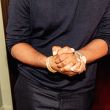'I was born in Columbia, Tennessee, but I grew up in Erie, Pennsylvania. That's where I started dancing and appreciating fashion and that kind of thing. I used to organize fashion shows with the neighborhood kids in my grandfather’s backyard...because my grandmother was a seamstress, she always had tons of clothing around. It was really funny, because she said I would be very, very strict—you had to be there at a certain time, you had to walk a certain way, you had to follow the rules—or I’d send you home! I would literally say, you have to go. Unfortunately, without pay…you know, thats how hardcore it was back then! [Laughs]
I came from a kind of hyper-creative family. My father's side was very creative, and my mother's side was much more academic. My mother worked at the Martin Luther King Jr. Center, which was also a super huge influence in my upbringing. They had this program called the Culture House and you could learn photography, sculpture, painting, anything. I wanted to become a painter. But one day some of the choreographers came to our class and they said they needed boys for an upcoming performance. So all the guys went to be in the dance performance. I’ll never forget—it was a very basic routine. And what happened was I loved it so much that they said, ‘Well, why don’t you stay?’ So I basically switched from painting to dance. We had these amazing teachers from California and New York who all became my friends. I often feel very, very blessed that I didn’t have that type of teaching where it was beat into you. It was all taught through love.
At 15 I got a scholarship to study dance at the Harkness House in New York, and after the scholarship they wanted me to join the Harkness Ballet. Back in my day, if you weren’t in a company by 17, your career was over. My mom said, ‘You know what? I don’t feel right about this. I want you to think really, really hard. You’re going to miss your last year of high school.’ And for some reason, I agreed to hold off. I finished high school and did a lot of great performances with my school at the time. And the Harkness House closed five months later! It would have been a disaster. Meanwhile, a lot of American dancers were leaving to go dance in Europe. And I had all these great French teachers, so when I was 17, I used all of my scholarship money to move to Europe.
I auditioned for one company in Brussels but they didn’t have a contract for me for that year, because I didn’t even know how to audition, basically. I didn’t know that when I would go to a dance audition, the contract would actually be for the next year. They said, ‘Why don’t you go to Stuttgart? Maybe they’ll have a contract for you now and you can dance with them for one year and then come back and join me in the next year.' So I went to Stuttgart and auditioned with Marcia Haydée, a hero of mine. I stayed there for a whole week, and I took class, and I was like, you know what? Forget Brussels, I want to work here. But she didn't have a contract for me either. So she said you can to go to Frankfurt for one year, which is only an hour-and-a-half by train.
Then I went to go see William Forsythe, who I’d never heard of, and he was at the height of his 'enfant terrible' attitude—he was the bad boy from America who was shaking everything up. He had just taken over the Frankfurt Ballet, which I was only interested in because it was close to Stuttgart. So I go in and I’m trying to take class, and Billy’s never there, and he keeps coming in at the end of class when it was all over, and I’m like, this is for the birds. I thought, I’m going to give this one more day. The next day he came and watched rehearsal and told me to stick around. He taught me this solo, which he had just taught at the Paris Opera. Then he gave me a contract to immediately start working. The rest is, unfortunately, as they say, history. Because I ended up absolutely loving my work with Billy—he taught me everything. We were literally trying to figure out how we could confuse ourselves every day we went into the studio. We never wanted to repeat ourselves. That’s kind of been my thinking in terms of how I approach a lot of things.
And then the whole thing with fashion started. Gianni [Versace] did costumes for three premieres for the Frankfurt Ballet—he would come to the first three rehearsals, then he’d go to Milan, design them, and have them produced. But little did he know that in that time in between, the ballet had completely changed! I was always watching the process, and that was one of the reasons often I think that Billy asked me to become the costume designer of the company. I really work with the dancers. Because I was a dancer, I understand what they need, and the changes of it—the piece is always growing, so I can't just say, ‘OK, I’ll see you 2 weeks before the premiere,’ and that’s it.
Then I started working with fashion shows. I think the first time was with Issey Miyake, because he had done costumes for us, and of course I was obsessed. To have someone like that working on costumes specifically for me…I was wearing these incredible Issey Miyake pieces which no one else could wear! Then one day I received a call…‘We need someone to help us with the show, and Issey wanted to know if you would be interested.’ I was doing a lot of costume coordinating for him at the Frankfurt Ballet, and then I fell into doing all of his shows. I was art director for Issey Miyake for about five years.
Issey led to working with The Rolling Stones because, at the time, Mick was looking for someone who understood theatre, but also had an understanding of fashion. So all those things together kind of brought me to be able to work with him. And then I started working with Inez and Vinoodh...they'd come to Frankfurt Ballet performances, and I was such a freaky fan of theirs, so we developed this relationship long distance. I got a call one day and they were like, ‘We’re going to be doing this Calvin Klein thing,’ and they wanted to have me to come in and work on the model's physicality and movement—it does not get any better than that.
I love Inez and Vinoodh because they're able to create an atmosphere in the studio. Bruce [Weber] also does it, and so does Mario Testino—I just worked on a TV commercial with him and Karlie Kloss. There’s a whole different generation of photographers today who are used to only working digitally, and that's very frustrating for me. It'll take me 10 minutes to build their movement up, and then all of a sudden the photographer is spending 15 minutes checking on his computer while she’s standing there, the energy has completely dropped, and we have to start all over again. They've never had to shoot a Polaroid and wait to see how it's turned out! The good photographers walk into it, and you shoot it, and you know it’s going to be right, so there’s no need for you to be checking it every step of the way.
I used to call myself a choreographer. But I realized what I’m doing on set, unless it’s specifically required of me, is not choreography. I’m directing a type of movement, and so my agent and I came up with the title Creative Movement Director. Let me tell you, within 24 hours of changing my title, all of a sudden, the clients went from being like, ‘We’re doing a hair commercial, why the fuck do we need a choreographer on set…?’ To… ‘We need to do this!’ The best models are always constantly in some stage of movement, and I work with them—Christy, Gisele, and Kate are all incredible. And now I’m getting more work with film, which is great, because it’s starting to become interesting to me. I’m getting requests from feature-length directors to collaborate on developing a movement vocabulary—how actors and actresses move. That’s really, really exciting.
As far as the dance scene is concerned here in the United States, it’s becoming extremely conservative. It’s literally reverting back to what it was years ago, because of money. People are not interested in taking risks anymore. The first four years of the Frankfurt Ballet were not successful, in terms of ticket sales or public, but they were beyond successful in terms of what we were able to experiment with—and only through experimentation are you able to develop. During the ‘80s and the ‘90s, you also had incredible heads-of-houses, artistic directors, who didn’t give a fuck about it being sold out...they wanted it to be new, they wanted to have great things happening, things that people had never seen before. And we don’t really have that anymore, because they just want a hit, and if it’s not a hit, then that director’s contract is up next season—his all-access pass is being revoked at the stage door because you’re going to get someone in who is able to push those numbers. But this thing with movement is it’s becoming super important—I read this one report that apparently like in 2019, almost like 40 percent of advertising will be digital, visual, video. We need to start getting this now, because it’s going to be everywhere. That fabulous campaign that you’re doing in Vogue Paris is now going to be a video on my phone, so you’ve got to turn the heat up a little bit more.”
—as told to ITG
Stephen Galloway photographed by Tom Newton in New York on October 12, 2015.
Watch the video that Stephen choreographed for Tom Ford's Spring 2016 presentation—and read more of The Professional here.












